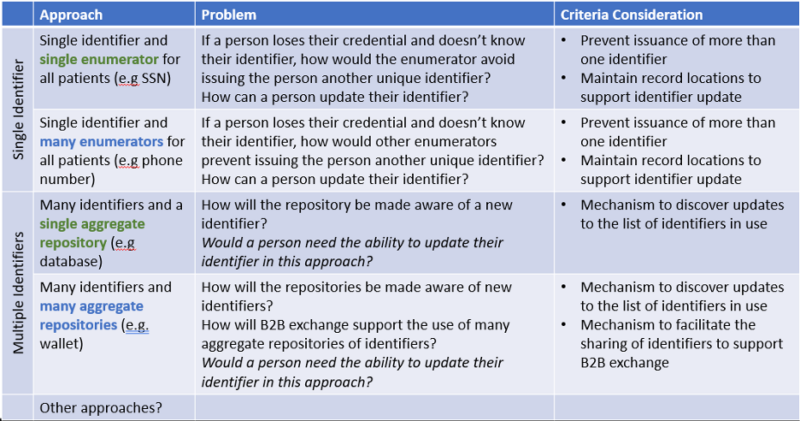I had a great time at the Civitas Annual Conference this year. While I was only able to attend for a short time I had the opportunity to present with some of my colleagues. Ryan Howells at the CARIN Alliance, Deven McGraw at Invitae, Marc Mar-Yohana at OtisHealth, and I presented on a panel session about the CARIN Digital Identity Proof of Concept. I also had the opportunity to gain some new perspectives from the other sessions and attendees.
Here are a few of my takeaways:
1. Identity resolution is a priority.
I had multiple conversations with sponsors of the event. One such sponsor was 4Medica which supports identity resolution among HIEs and other organizations in healthcare. The perspective I heard echoed much of the same perspective that we determined in the PEHRLS Consensus Body. One topic we discussed was the four potential types of identifiers that might be used for patient matching in the future. The table below outlines the PEHRLS CB conclusions. For those of you who are unfamiliar with the term enumerator, the PEHRLS CB uses that term to label an entity that issues identifiers, such as a hospital creating an EMPI or the Social Security Administration issuing social security numbers. The group also concluded that there may be more than these four patterns.

2. The implications of TEFCA mean something completely different to different organizations.
For some, TEFCA appears to be an existential crisis to their business model. However, the conversation I sat in on at one of the sessions on this topic suggested that this may not be the case. While TEFCA is focused on the national exchange of health records, the additional value that HIEs provide healthcare like delivering lab results via Direct and compiling complete and accurate patient stories is still a necessary capability. The session indicated that HIEs who deliver value to providers that go beyond the delivery of raw data will be able to continue delivering that value in a post-TEFCA world.
This perspective of caution, or perhaps even fear by some, is contrasted with the perspective of opportunity by others. I also spoke with a few sponsors offering FHIR servers to help organizations adopt the Facilitated FHIR approach to supplement health information exchange. For those attendees, the future is bright and full of green pastures glistening with the potential for new business.
Yet a third perspective I heard is that TEFCA is moot because it won’t work or won’t be successful.
I found the polarization of these perspectives very interesting to appear so clearly at the same conference. The underlying theme suggested it’s clear that TEFCA will create changes if it achieves its goals, but those changes may not cause as much of a binary shift in healthcare as some foresee. I won’t venture my own guess as to which way the wind will blow, mainly because I feel less educated about the topic than most others who offered their opinions. The only hypothesis I would make is that none of the extremes are likely to come to fruition. The result will likely be something that blends all three perspectives together. It may be harmful to some businesses, beneficial for others, and have no impact at all to other businesses. We are pioneering new ground in health IT these days and if nothing else, I’m enjoying the show.
This post was contributed by Kyle Neuman, DirectTrust Director of Trust Framework Development.
